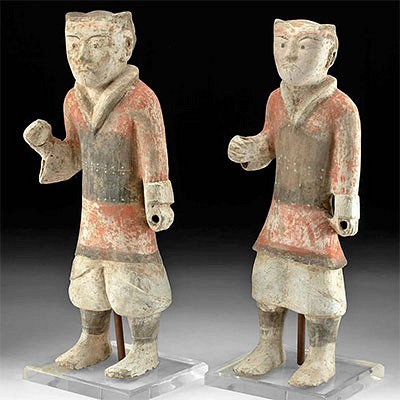Native American Archaic Banded Slate Bannerstone
Lot 73d
About Seller
Artemis Fine Arts
686 S Taylor Ave, Ste 106
Louisville, CO 80027
United States
Selling antiquities, ancient and ethnographic art online since 1993, Artemis Gallery specializes in Classical Antiquities (Egyptian, Greek, Roman, Near Eastern), Asian, Pre-Columbian, African / Tribal / Oceanographic art. Our extensive inventory includes pottery, stone, metal, wood, glass and textil...Read more
Categories
Estimate:
$1,000 - $1,500
Absentee vs Live bid
Two ways to bid:
- Leave a max absentee bid and the platform will bid on your behalf up to your maximum bid during the live auction.
- Bid live during the auction and your bids will be submitted real-time to the auctioneer.
Bid Increments
| Price | Bid Increment |
|---|---|
| $0 | $25 |
| $300 | $50 |
| $1,000 | $100 |
| $2,000 | $250 |
| $5,000 | $500 |
| $10,000 | $1,000 |
| $20,000 | $2,500 |
| $50,000 | $5,000 |
| $100,000 | $10,000 |
| $200,000 | $20,000 |
About Auction
By Artemis Fine Arts
May 25, 2023
Set Reminder
2023-05-25 10:00:00
2023-05-25 10:00:00
America/New_York
Bidsquare
Bidsquare : ON-SALE! Antiquities, Pre-Columbian, Ethno, Fine Art
https://www.bidsquare.com/auctions/artemis-gallery/on-sale-antiquities-pre-columbian-ethno-fine-art-12860
ON-SALE Antiquities, Pre-Columbian, Ethno, More! Artemis Fine Arts info@artemisfinearts.com
ON-SALE Antiquities, Pre-Columbian, Ethno, More! Artemis Fine Arts info@artemisfinearts.com
- Lot Description
Native American, Midwestern United States, Indiana, St. Joseph County, Archaic Period, ca. 5000 to 1000 BCE. A well-preserved gray and black banded slate bannerstone, perhaps used as a tool for hunting. The stone has been carved to an elongated shape with rounded, blade like tips, and a perforation drilled through the center. This perforation allowed the bannerstone to be attached onto a circular piece of wood that formed part of an atlatl. It is thought that the weight gave the atlatl greater power and control. Bannerstones probably had ritualistic or symbolic power as well as functional since great care was taken in shaping and polishing this stone. Size: 4.8" L x .75" W x 1.5" H (12.2 cm x 1.9 cm x 3.8 cm)
Bannerstones remain an archaeological mystery. For many years, inspired by research done by a former physicist, archaeologists believed that bannerstones were used as weights to give atlatls greater power and control. Later experimental archaeology proved that this was not true - but did open up the possibility that the bannerstone helped with fatigue when holding an atlatl still, while stalking skittish prey like deer. However, their elaborate designs, and some examples that are too large to have ever been useful, suggest that they also had a ritualistic purpose.
Provenance: private Kansas City, Missouri, USA collection; ex-John Townsend collection, formed in the 1970s and earlier
All items legal to buy/sell under U.S. Statute covering cultural patrimony Code 2600, CHAPTER 14, and are guaranteed to be as described or your money back.
A Certificate of Authenticity will accompany all winning bids.
We ship worldwide and handle all shipping in-house for your convenience.
#162013Find site and collection name written on both sides. Scratches and surface wear. Chips and losses especially on corners and peripheries. Smooth surface.Condition
- Shipping Info
-
All shipping is handled in-house for your convenience. Your invoice from Artemis Gallery will include shipping calculation instructions. If in doubt, please inquire BEFORE bidding for estimated shipping costs for individual items.
-
- Buyer's Premium



 EUR
EUR CAD
CAD AUD
AUD GBP
GBP MXN
MXN HKD
HKD CNY
CNY MYR
MYR SEK
SEK SGD
SGD CHF
CHF THB
THB










